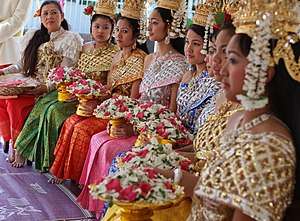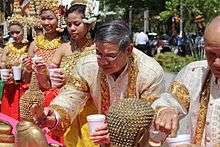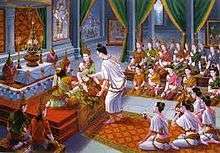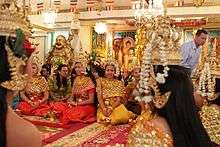Cambodian New Year
| Cambodian New Year | |
|---|---|
 Young women at a Khmer New Year celebration in Lithonia, Georgia, US, 2010. | |
| Official name |
Cambodian New Year បុណ្យចូលឆ្នាំថ្មី |
| Also called | Choul Chnam Thmey |
| Observed by | Khmers |
| Significance | Marks the Cambodian New Year |
| Begins | 14 April |
| Ends | 16 April |
| Date | 14 April |
| 2017 date | 14 April, Rooster |
| 2018 date | 14 April, Dog |
| 2019 date | 13 April, Pig |
| 2020 date | 13 April, Rat |
| Frequency | annual |
| Related to | South and Southeast Asian New Years |
Cambodian New Year (Khmer: បុណ្យចូលឆ្នាំថ្មី) or Choul Chnam Thmey in the Khmer language, literally "Enter New Year", is the name of the Cambodian holiday that celebrates the traditional Lunar New Year.[1] The holiday lasts for three days beginning on New Year's Day, which usually falls on April 13th or 14th, which is the end of the harvesting season, when farmers enjoy the fruits of their labor before the rainy season begins. Khmers living abroad may choose to celebrate during a weekend rather than just specifically April 13th through 16th. The Khmer New Year coincides with the traditional solar new year in several parts of India, Nepal, Sri Lanka, Myanmar, Laos and Thailand.
Cambodians also use Buddhist Era to count the year based on the Buddhist calendar. For 2018, it will be 2562 BE (Buddhist Era).[2]
The three days of the new year

Maha Sangkran (មហាសង្រ្កាន្ត)
Maha Sangkran, derived from Sanskrit Maha Sankranti, is the name of the first day of the new year celebration. It is the end of the year and the beginning of a new one. People dress up and light candles and burn incense sticks at shrines, where the members of each family pay homage to offer thanks for the Buddha's teachings by bowing, kneeling and prostrating themselves three times in front of his image. For good luck people wash their face with holy water in the morning, their chests at noon, and their feet in the evening before they go to bed.
Virak Vanabat (វិរ:វ័នបត)
Vireak Vanabat is the name of the second day of the new year celebration. People contribute charity to the less fortunate by helping the poor, servants, homeless, and low-income families. Families attend a dedication ceremony to their ancestors at monasteries.
Vearak Loeng Sak (វារៈឡើងស័ក)
T'ngai Loeng Sak in Khmer is the name of the third day of the new year celebration. Buddhists wash the Buddha statues and their elders with perfumed water. Bathing the Buddha images is a symbolic practice to wash bad actions away like water clean dirt from household items. It is also thought to be a kind deed that will bring longevity, good luck, happiness and prosperity in life. By washing their grandparents and parents, the children can obtain from them best wishes and good pieces of advice to live the life for the rest of the year.
New Year's customs

In temples, people erect a sand hillock on temple grounds. They mound up a big pointed hill of sand or dome in the center which represents Valuka Chaitya, the stupa at Tavatimsa where the Buddha's hair and diadem are buried. The big stupa is surrounded by four small ones, which represent the stupas of the Buddha's favorite disciples: Sariputta, Moggallana, Ananda, and Maha Kassapa. There is another tradition called Sraung Preah (ស្រង់ព្រះ) : pouring water or liquid plaster (a mixture of water with some chalk powder) on elder relative, or people (mostly the younger generation is responsible for pouring the water).
The Khmer New Year is also a time to prepare special dishes. One of these is a "kralan": a cake made from steamed rice mixed with beans or peas, grated coconut and coconut milk. The mixture is stuffed inside a bamboo stick and slowly roasted.[3]
Traditional games (ល្បែងប្រជាប្រិយ)

Cambodia is home to a variety of games played to transform the dull days into memorable occasions. These games are similar to those played in Manipur, a north-eastern state in India.[4] Throughout the Khmer New Year, street corners often are crowded with friends and families enjoying a break from routine, filling their free time with dancing and games. Typically, Khmer games help maintain one's mental and physical dexterity.
- "Chol Chhoung (ចោលឈូង)"
A game played especially on the first nightfall of the Khmer New Year by two groups of boys and girls. Ten or 20 people comprise each group, standing in two rows opposite each other. One group throws the "chhoung" to the other group. When it is caught, it will be rapidly thrown back to the first group. If someone is hit by the "chhoung," the whole group must dance to get the "chhoung" back while the other group sings to the dance.
- "Chab Kon Kleng (ចាប់កូនខ្លែង)"
A game played by imitating a hen as she protects her chicks from a crow. Adults typically play this game on the night of the first New Year's Day. Participants usually appoint a strong player to play the hen who protects "her" chicks, while another person is picked to be the "crow". While both sides sing a song of bargaining, the crow tries to catch as many chicks as possible as they hide behind the hen.
- "Bos Angkunh (បោះអង្គុញ)"
The simple style consists of just throwing the Ongkunhs to hit the target Ongkunhs. The extended style adds five more stages in addition to the throwing stage. Both styles end with a penalty called Jours-activity that the winning team members get to perform on the losing team members. The Jours-activity is performed by using the Onkunghs the hit the knees of the losing team.
- "Leak Kanseng (លាក់កន្សែង)"
A game played by a group of children sitting in a circle. Someone holding a "kanseng" (Cambodian towel) that is twisted into a round shape walks around the circle while singing a song. The person walking secretly tries to place the "kanseng" behind one of the children. If that chosen child realizes what is happening, he or she must pick up the "kanseng" and beat the person sitting next to him or her.
- "Bay Khom(បាយខុម)"
A game played by two children in rural or urban areas during their leisure time. Ten holes are dug in the shape of an oval into a board in the ground. The game is played with 42 small beads, stones or fruit seeds. Before starting the game, five beads are put into each of the two holes located at the tip of the board. Four beads are placed in each of the remaining eight holes. The first player takes all the beads from any hole and drops them one by one in the other holes. He or she must repeat this process until they have dropped the last bead into a hole that lies besides any empty one. Then they must take all the beads in the hole that follows the empty one. At this point, the second player may have his turn. The game ends when all the holes are empty. The player with the greatest number of beads wins the game. It is possibly similar to congkak.
Angkor Sangkran (អង្គរសង្ក្រាន្ត)
Sanskrit (Angkor Sangkranta) is an event of Khmer New Year organized by the Union of Youth Federations of Cambodia (UYFC) which is held in Siem Reap province from 14–16 April. Culture event action-packed Angkor Sangkran is an opportunity for all Cambodians as a united Khmer Family and for foreign friends to receive unforgettable and exquisite experiences during Khmer New Year in Cambodia.
Dates in Khmer calendar
| Gregorian | Date | Animal | Day of the week | Gregorian | Date | Animal | Day of the week | |
|---|---|---|---|---|---|---|---|---|
| 2001 | 13 April | Snake | Friday | 2026 | 13 April | Horse | Tuesday | |
| 2002 | 13 April | Horse | Saturday | 2027 | 13 April | Goat | Thursday | |
| 2003 | 13 April | Goat | Sunday | 2028 | 13 April | Monkey | Saturday | |
| 2004 | 13 April | Monkey | Tuesday | 2029 | 13 April | Rooster | Sunday | |
| 2005 | 13 April | Rooster | Wednesday | 2030 | 13 April | Dog | Monday | |
| 2006 | 13 April | Dog | Thursday | 2031 | 13 April | Pig | Tuesday | |
| 2007 | 13 April | Pig | Friday | 2032 | 13 April | Rat | Thursday | |
| 2008 | 13 April | Rat | Sunday | 2033 | 13 April | Ox | Friday | |
| 2009 | 13 April | Ox | Monday | 2034 | 13 April | Tiger | Saturday | |
| 2010 | 13 April | Tiger | Tuesday | 2035 | 13 April | Rabbit | Sunday | |
| 2011 | 13 April | Rabbit | Wednesday | 2036 | 13 April | Dragon | Tuesday | |
| 2012 | 13 April | Dragon | Friday | 2037 | 13 April | Snake | Wednesday | |
| 2013 | 13 April | Snake | Saturday | 2038 | 13 April | Horse | Thursday | |
| 2014 | 13 April | Horse | Sunday | 2039 | 13 April | Goat | Friday | |
| 2015 | 13 April | Goat | Monday | 2040 | 13 April | Monkey | Sunday | |
| 2016 | 13 April | Monkey | Wednesday | 2041 | 13 April | Rooster | Monday | |
| 2017 | 14 April | Rooster | Friday | 2042 | 13 April | Dog | Tuesday | |
| 2018 | 14 April | Dog | Saturday | 2043 | 13 April | Pig | Wednesday | |
| 2019 | 13 April | Pig | Saturday | 2044 | 13 April | Rat | Friday | |
| 2020 | 13 April | Rat | Monday | 2045 | 13 April | Ox | Saturday | |
| 2021 | 13 April | Ox | Tuesday | 2046 | 13 April | Tiger | Sunday | |
| 2022 | 13 April | Tiger | Thursday | 2047 | 13 April | Rabbit | Monday | |
| 2023 | 13 April | Rabbit | Friday | 2048 | 13 April | Dragon | Wednesday | |
| 2024 | 13 April | Dragon | Sunday | 2049 | 13 April | Snake | Thursday | |
| 2025 | 13 April | Snake | Monday | 2050 | 13 April | Horse | Friday |
See also
References
| Wikimedia Commons has media related to Khmer New Year. |
- ↑ https://books.google.com.au/books?id=9J6kBQAAQBAJ&printsec=frontcover#v=onepage&q=Lunar%20New%20Year%20&f=false
- ↑ "Buddhist Calendar". UTBF.ORG. April 2016. Retrieved 2016-04-01.
- ↑ Nhem, Chea Bunly (May 22–23, 2004). "Let Them Eat Cake". The Cambodia Daily. Archived from the original on 2007-08-29. Retrieved 2009-01-11.
- ↑ Singh, Atom Sunil; Indigenous Games of Cambodia and Manipur